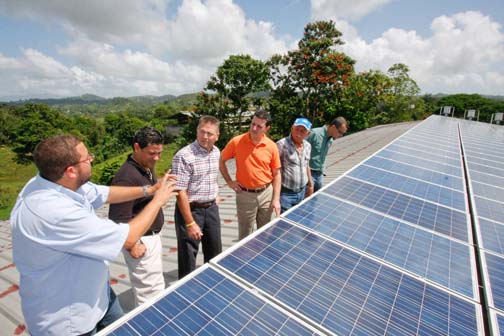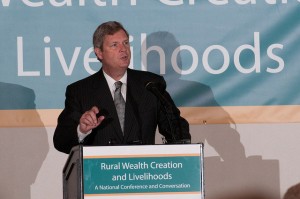Ag. Sec.: Farming activity needs private banking support


Agriculture Secretary Javier Rivera Aquino (in orange) tours a $160,000 renewable energy system installed at San Lorenzo dairy farm, La Maratón, Monday. The Agriculture Department and the USDA provided financing, as did the dairy's owners. The local agency is making $2 million available for these types of projects.
Agriculture Secretary Javier Rivera-Aquino has set off an aggressive strategic plan to convince private banks, which for years have shied away from the volatile sector, to invest in farming activity and new projects.
The initiative calls for working jointly with banks to maximize government incentives through investments, he said.
“We have a considerable amount of potential agricultural entrepreneurs, young professionals from various fields who are interested in venturing into the agriculture business with promising projects,” Rivera-Aquino said. “We, the government, we can provide land, incentives, training and even some funding through the programs we have developed in conjunction with the Economic Development Bank.”
“However, to grow at a faster rate and significantly expand the sector, we need to integrate the private banking sector in these projects,” he said, mentioning the U.S. Department of Agriculture’s Farm Service Agency and Puerto Rico Farm Credit as active partners in extending financing and credit to farmers.
Over the past decade, participation by the private banking sector in agricultural activity has dwindled significantly, especially in light of the harsh economic circumstances that have led many farmers to default on loans and even seek bankruptcy to deal with their financial problems. As a result, banks have become stricter when lending to farmers, which have been turning more to the EDB and other government sources of funding.
“Private banking for years has promoted far-reaching agricultural projects. The circumstances that we have all experienced in the last seven years have brought new challenges, including the adoption of new stricter rules when granting funding,” Rivera-Aquino acknowledged, lobbying for keeping communications lines open to spur adequate investments in the sector.
So far, Rivera-Aquino has met with a number of banking executives to exchange data and projections. According to the agency’s latest statistics available online, the island’s farming sector generated nearly $794 million in gross income in fiscal 2009. That total represented a 3 percent increase from the prior fiscal year’s results.
“We wanted to lay the groundwork with financial institution representatives to create the enabling environment that will allow gathering agricultural entrepreneurs, investors and bankers to do business at the same table,” he said. “Market opportunities and government support are there. It remains for the parties to seek common ground to associate.”
Patrick Haggarty, executive vice president of BBVA Puerto Rico’s wholesale banking, said the agency’s efforts to drive incentives, training and financing programs “is a positive step,” toward future collaborations.
“We welcome the search for additional direct investment mechanisms and guarantees that ease financing for the farming sector, which BBVA Puerto Rico has always and constantly supported,” he said.
In coming weeks, the Agriculture Department will host a visit from stateside Farm Credit Administration and Farmer Mac officials.
Local efforts mirror USDA’s push
U.S. Agriculture Secretary Tom Vilsack was in Iowa Thursday also pushing for the future of the sector, which he said is a key element for future economic prosperity.
“What we do on the farm ripples through the economy and helps to create jobs, particularly when agriculture is thriving. What’s more, the productivity of American farmers and ranchers help American families stretch their paychecks,” Vilsack said.
In his speech, Vilsack pointed out that on the mainland, “farm debt is falling and farm equity is growing,” which puts U.S. agriculture on “sound footing.”
“But we didn’t get here by accident,” he said. “We’re here because of the policies and the investments that have been made over the course of many decades.”
He also said that while the agriculture sector will always pose a risk, it is important that there be a combination of public and private funding and investments flowing, so farmers are able to meet the growing global demand for food.
That funding needs to be pumped into research and conservation, two areas that are “important components” for sustainable productivity.
“Now, given limited federal resources, we also need to find creative ways to incent the private sector to invest in conservation,” Vilsack said.















